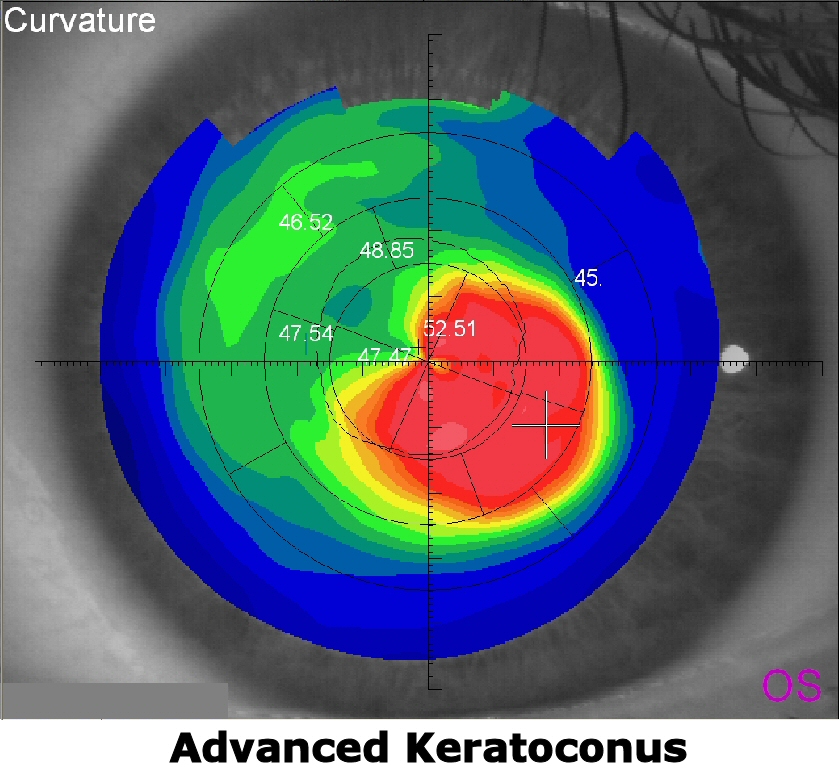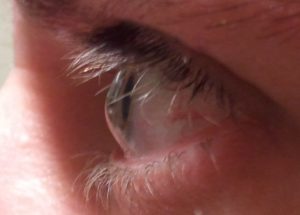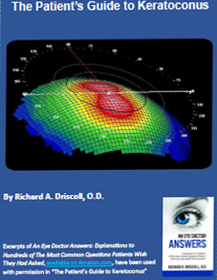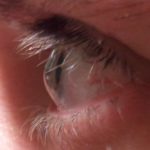One of the first questions asked by a newly diagnosed keratoconus patient is “can keratoconus be treated”? The answer is a resounding yes. Keratoconus can be treated successfully via a number of safe and effective methods.
Contact Lenses – The Most Effective Keratoconus Treatment
Contact lenses are the most common, safest, and effective keratoconus treatment available. As Steph Curry, an NBA All-Star point guard for the Golden State Warriors, recently found out. During an interview, he commented on how his keratoconus lenses brought everything into focus.
Numerous types of contact lenses are used to treat keratoconus. RGP contact lenses, while still commonly used, are being replaced by scleral contacts as the most common and effective keratoconus treatment.
Can Keratoconus be Treated with Surgery?
Keratoconus can be treated with surgery; however, like conditions such as diabetes and high blood pressure, we can’t cure keratoconus with surgery.
Corneal Cross Linking
The most common surgical option for keratoconus is Corneal Cross-Linking. You may see this abbreviated as CCL or CXL. Cross-linking helps stabilize the cornea by increasing the connections between collagen fibers. In most cases, cross-linking will stop the progressive steepening of the cornea. Following cross-linking, patients often further improve their visual acuity with scleral contact lenses.
Penetrating Keratoplasty – Corneal Transplant
Corneal transplants have decreased in popularity since the FDA approved corneal cross-linking. Corneal scarring and corneal hydrops are the most common reasons for corneal transplants.
How do I Learn More About My Keratoconus Treatment Options?
We offer complementary keratoconus treatment consults with Dr. Driscoll to help patients decide which treatment option is best for them. You can schedule your free consultation online with Dr. Driscoll at either our Colleyville or Keller/Southlake Location. We can also schedule your appointment by us calling at .
About Dr. Driscoll
Dr. Driscoll is a therapeutic optometrist and keratoconus specialist at Total Eye Care in Colleyville, Texas. A 1988 Graduate of the Illinois College, Dr. Driscoll has been treating patients with keratoconus for over 30 years. Following Dr. Driscoll’s Graduation from the Illinois College of Optometry, he joined the residency program at the Tuscaloosa VA Medical Center in Tuscaloosa, Alabama. Dr. Driscoll likes to write. He wrote An Eye Doctor Answers: Explanations To Hundreds Of The Most Common Questions Patients Wish They Had Asked, available on Amazon.com, and The Patient’s Guide to Keratoconus.


 November 10 is National Keratoconus Day. Keratoconus is an ocular condition causing debilitating decreased vision in approximately 1 in 400 to 1 in 2000 Americans. Below is a brief overview of keratoconus. For a complete review of keratoconus, including background information, diagnosis, treatment, and prognosis can be found here
November 10 is National Keratoconus Day. Keratoconus is an ocular condition causing debilitating decreased vision in approximately 1 in 400 to 1 in 2000 Americans. Below is a brief overview of keratoconus. For a complete review of keratoconus, including background information, diagnosis, treatment, and prognosis can be found here The Keratoconus Doctors website is now available. Over the years Total Eye Care has developed a sub-specialty in keratoconus treatment. We now have a website dedicated to those patients.
The Keratoconus Doctors website is now available. Over the years Total Eye Care has developed a sub-specialty in keratoconus treatment. We now have a website dedicated to those patients. Scleral lenses have been around for over 100 years. Until the new gas permeable lens materials were developed patients could only wear scleral lenses for a few hours a day. With the highly oxygen permeable lens materials now in use, patients can comfortably wear these lenses all day. Scleral contacts are most commonly used to treat eyes with irregular corneas such as keratoconus and post-surgical eyes (usually following corneal transplant surgery or related to complications from refractive surgery). Another common use for scleral contact lenses is in the special effects industry where they are used to protect the cornea and/or to give the eye an exotic appearance.
Scleral lenses have been around for over 100 years. Until the new gas permeable lens materials were developed patients could only wear scleral lenses for a few hours a day. With the highly oxygen permeable lens materials now in use, patients can comfortably wear these lenses all day. Scleral contacts are most commonly used to treat eyes with irregular corneas such as keratoconus and post-surgical eyes (usually following corneal transplant surgery or related to complications from refractive surgery). Another common use for scleral contact lenses is in the special effects industry where they are used to protect the cornea and/or to give the eye an exotic appearance. Due to the fact that one of the specialties at Total Eye Care is keratoconus we see many patients with this condition. We recently updated our patient information on keratoconus page to reflect some of the new technologies available to our patients such as;
Due to the fact that one of the specialties at Total Eye Care is keratoconus we see many patients with this condition. We recently updated our patient information on keratoconus page to reflect some of the new technologies available to our patients such as;